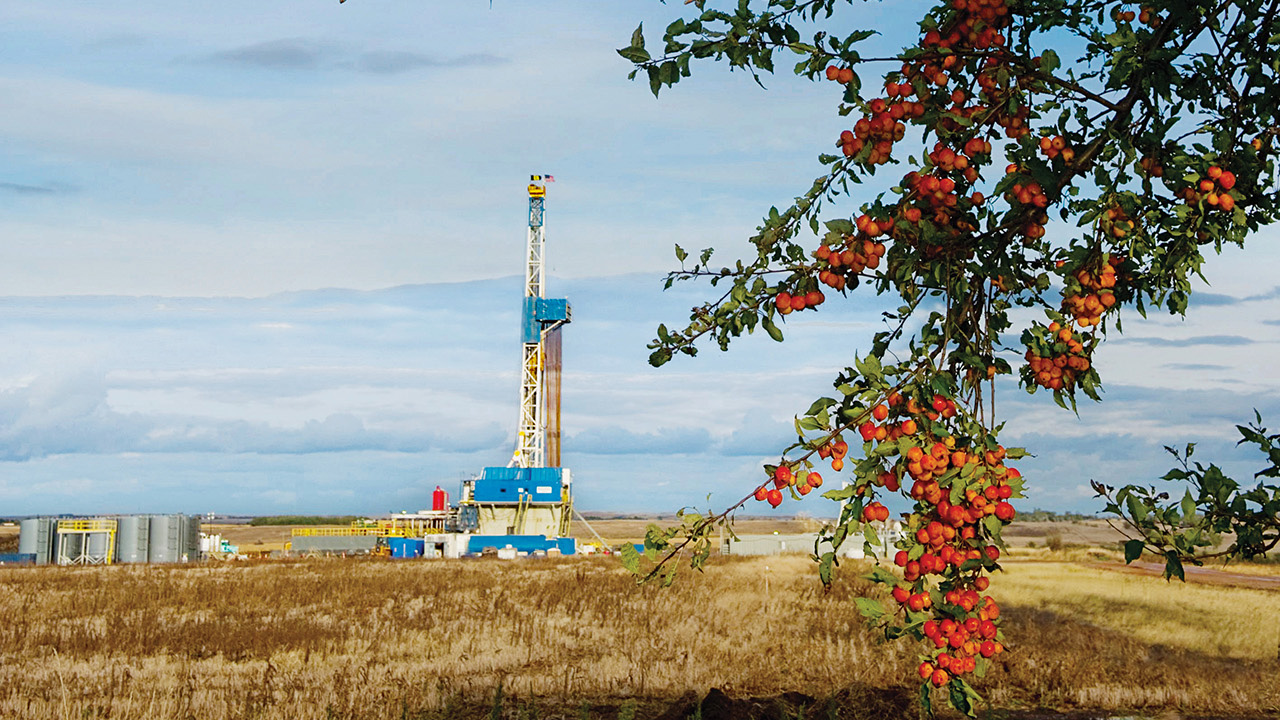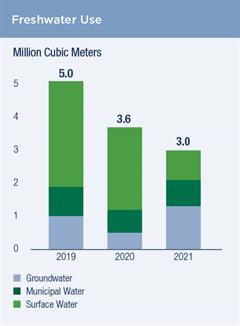
Safeguarding the environment is a core commitment for Hess and incorporated into the Hess Values. We seek to continuously improve our performance across the range of potential environmental impacts, including water and energy use, air emissions, waste and spills, and doing so is embedded in the Hess Operational Management System that guides the work we do every day. We dedicate significant staff and resources to this effort to help ensure compliance with environmental laws and regulations, international standards and voluntary commitments. We have developed specific goals and key performance metrics to drive and track improvements in our environmental performance at both the enterprise and asset levels. Some of these metrics are factored into our annual incentive plan, helping to further advance our culture of environmental stewardship.
A summary of some of our water management program and related key performance follows. For a detailed description of our management of water, biodiversity, waste and air emissions, in addition to an overview of our spill prevention program, lifecycle approach to well integrity, and regulatory compliance and legal proceedings, please refer to our 2021 Sustainability Report. Leak Detection and Repair and Shale Energy, described online, contains content supplementary to our 2021 Sustainability Report.
Water Management
 At Hess, we know that the communities and ecosystems where we operate depend on water to thrive and our operations have the potential to impact this resource, primarily through our use of fresh water and possible impacts on water quality that could occur due to well integrity issues, spills or discharges. Responsible water management is a focus of our environmental efforts and continues to be one of our key sustainability issues.
At Hess, we know that the communities and ecosystems where we operate depend on water to thrive and our operations have the potential to impact this resource, primarily through our use of fresh water and possible impacts on water quality that could occur due to well integrity issues, spills or discharges. Responsible water management is a focus of our environmental efforts and continues to be one of our key sustainability issues.
We primarily use fresh water in our onshore upstream operations for drilling and completions, and for cooling in midstream gas processing. We also use fresh water in our offshore operations for some drilling activities and to supply potable water to personnel; however, we primarily meet these needs by converting seawater to fresh water through reverse osmosis.
Hess’ total freshwater use in 2021 decreased by 17% compared with 2020. The largest driver of this decrease was a 20% reduction in freshwater use in our onshore drilling and completions operations in the U.S. This decrease was largely the result of a planned reduction in activity – we drilled eight fewer wells and hydraulically fractured 48 fewer wells in 2021 than in 2020.
Leak Detection and Repair
Hess employs a leak detection and repair (LDAR) program in North Dakota. The LDAR program covers each fugitive emissions component at these facilities.
Our LDAR field assurance team conducts audible, visual and olfactory (AVO) inspections and optical gas imaging (OGI) on equipment that has the potential to emit fugitive emissions. The AVO inspections are scheduled monthly. OGI is conducted semiannually by trained operational personnel at our production operations in North Dakota and quarterly at our gas plant and compressor stations in the state.
AVO inspections involve making observations (e.g., of fluids dripping, spraying, misting or clouding from or around components), listening for sounds (e.g., hissing) and noting smells (because Hess equipment is typically in mixed hydrocarbon service so volatile organic compounds are typically present when leaks are identified). During the monthly AVO inspections, and as part of their daily work, reliability operators monitor equipment for leaks and document the results. We require reliability operators to be trained and experienced in the appropriate operation of the equipment involved in their work activities and to be familiar with Hess operations in the areas where they work. They are also required to complete training on the Hess standard work documents for equipment subject to AVO inspection.
OGI is performed by field assurance personnel in our regulatory group who are certified in the use of infrared thermal cameras and other monitoring techniques, such as U.S. Environmental Protection Agency (EPA) Method 21, to detect fugitive emissions.
If a leak is found during inspection, we have a “first attempt” deadline of five days for repair. If a repair within five days is not feasible, the leak is documented and a fix is required within 30 days.
In 2021, we repaired 1,488 fugitive emissions components in North Dakota. This avoided 16,660 tonnes of carbon dioxide emissions based on the EPA standard leak rates. We also replaced all remaining high bleed pneumatic controllers (see page 50 of our 2021 Sustainability Report for more detail). These measures, together with the steps we are taking to reduce flaring, will help to further reduce our fugitive emissions in North Dakota.